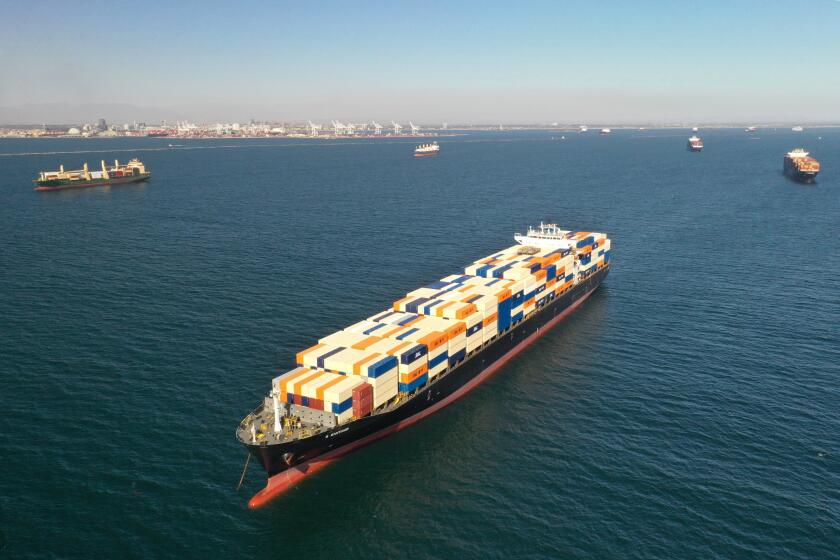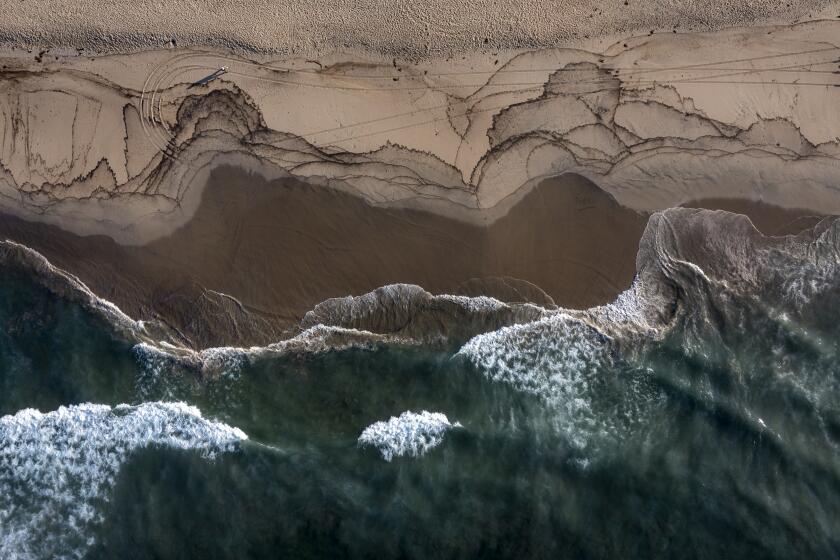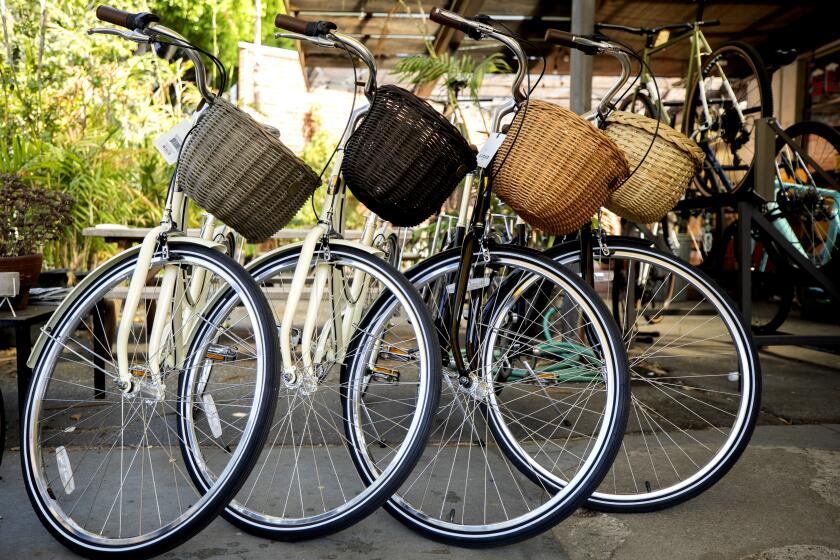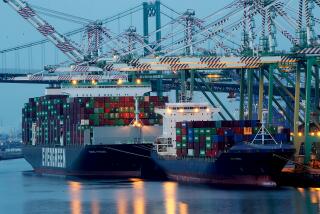Investigators examine role of unprecedented port gridlock in O.C. oil spill
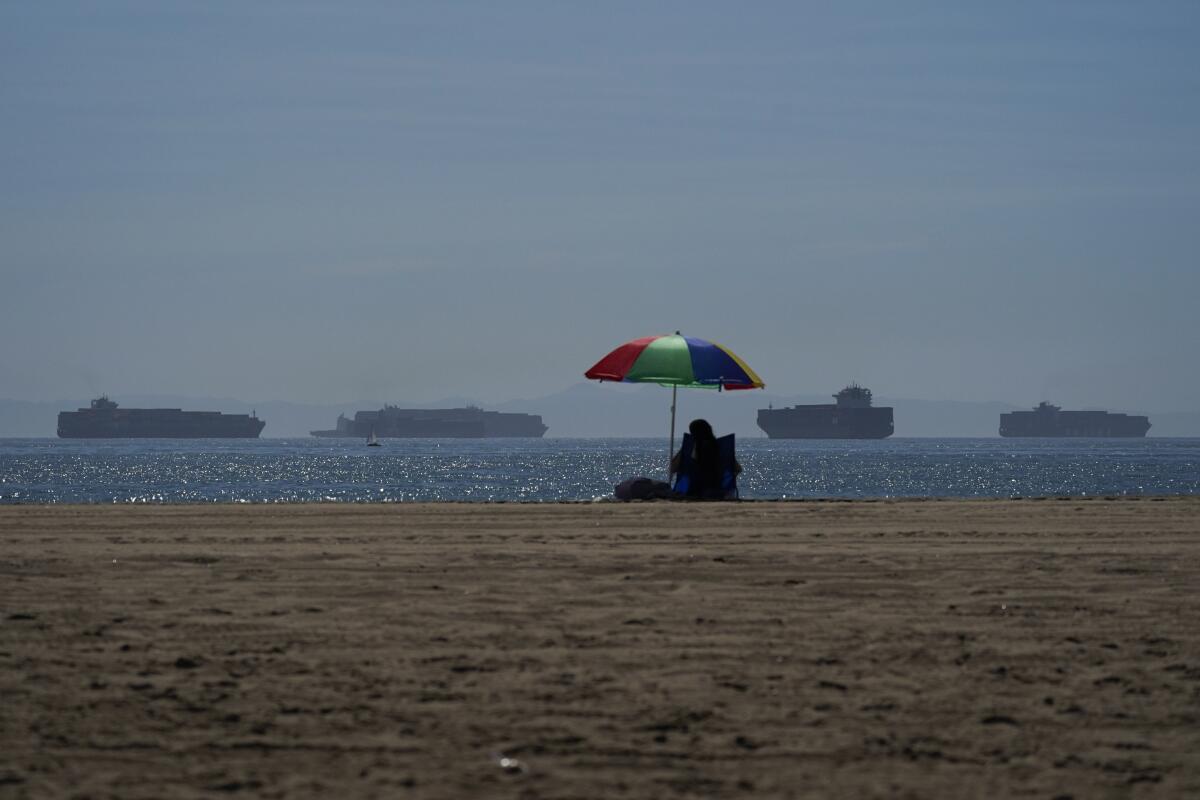
With the ports of Los Angeles and Long Beach facing unprecedented gridlock, investigators are trying to determine what role the congested shipping lanes played in the massive oil spill that has fouled the Orange County coast since early this month.
Investigators are probing possible issues with the way ships are anchoring or drifting off the coast in long lines caused by skyrocketing consumer demand and disrupted supply chains during the pandemic.
Officials believe a ship anchored off Huntington Beach hit an undersea pipe, possibly months before the oil began spilling in the ocean. It’s unclear how a ship came to lower its anchor on a pipeline when the placement of vessels is supposed to be carefully orchestrated to avoid such mishaps.
A global supply chain breakdown has resulted in gridlock at the ports of Los Angeles and Long Beach and beyond.
But the offshore traffic jams have forced ships to wait well beyond their usual zones, dropping enormous anchors near oil platforms and an undersea infrastructure of oil lines.
The Coast Guard and the National Transportation Safety Board are focusing on a period early this year when heavy winds may have shifted large vessels over the pipeline. They are examining which vessels were in the vicinity on Jan. 24 and 25 and gathering data on every vessel traveling near the pipeline since last October.
In the coming weeks, investigators expect to board several foreign vessels to see whether they were anchored near the pipeline in the last year.
Coast Guard investigators have examined several ships that were in the area in the days before the leak and concluded that none of them are likely responsible for the damage to the pipeline, which was last inspected in October 2020.
An oil slick believed to have originated from a pipeline leak has hit Huntington Beach, closing a stretch of beach and raising grave wildlife and environmental concerns.
However, U.S. Coast Guard Capt. Jason Neubauer said no vessels have been completely ruled out. The investigators are focusing primarily on ship traffic at the Port of Long Beach but are also looking at Los Angeles.
An initial ship strike may have moved the pipeline without breaking it. Another collision, or possibly a geological event, could have either “increased the fracture or caused the whole thing,” Neubauer said.
The Los Angeles and Long Beach ports are among the busiest in the country.
On Sept. 19, a record 73 container ships and 97 ships of all types were anchored waiting to enter the ports — some in a “drift area” used for overflow traffic.
Until 2020, it was typical for only one container ship to be anchored offshore.
Tuesday morning, the traffic jam was down to 30 container ships heading to the Port of Los Angeles and 28 destined for the Port of Long Beach.
As shoppers and retailers gear up for the holidays, pressure on the ports is likely to intensify.
Shortages of everything from bicycles to electronics are expected, not to mention the hot toys of the season.
Many items destined for retailer shelves this holiday season are hopelessly snarled in the global supply chain. What does that mean for shoppers?
On Tuesday, Rep. Michelle Steel (R-Seal Beach) introduced legislation seeking to ban cargo ships idling or anchoring 24 nautical miles or less off the Orange County coast.
She called the idling ships “an environmental and public health crisis.”
In addition to the Coast Guard and NTSB, the California attorney general and Orange County district attorney’s office have launched investigations into the spill. The probes could lead to criminal charges and civil penalties and will probably be used in several class-action lawsuits against Amplify Energy, the oil pipeline owner, legal experts say.
Neubauer said a large vessel grappling with rough conditions may have been unaware that its anchor clipped a pipeline.
In a 2018 incident in the Great Lakes, a barge anchor slashed through three underwater cables and two pipelines, leading to an 800-gallon oil spill. The crew wasn’t immediately aware of the accident.
In Orange County, a 13-inch tear in the pipeline caused a minimum of about 24,696 gallons and a maximum of 131,000 gallons of oil to spill into the ocean, resulting in a slick that has devastated the coast for more than a week.
Oil began rolling into Huntington Beach on Oct. 3. Tar balls have washed up as far south as San Diego County, fouling beaches, killing wildlife and prompting a massive cleanup.
Investigators plan to remove the cracked section of the pipeline and bring it to a lab so the NTSB metallurgy experts can determine when it was damaged and when it began leaking.
Times staff writer Thomas Curwen contributed to this report.
More to Read
Sign up for Essential California
The most important California stories and recommendations in your inbox every morning.
You may occasionally receive promotional content from the Los Angeles Times.
